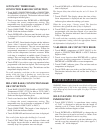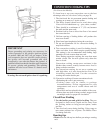
•Use a roasting pan that fits the size of the food to be
roasted. Meat juices may overflow the sides of a pan that
is too small. Too large of a pan will result in increased
over spatter.
•Spatter can be reduced by lining the bottom of the
roasting pan with lightly crushed aluminum foil.
•A foil tent will slow down surface browning for long-
term roasting, as when roasting a turkey. Place tent-
shaped foil loosely over meat to allow for air circulation.
Do not seal foil or meat will be steamed.
•Use an accurate meat thermometer to determine when
meat has reached desired degree of doneness. Insert the
thermometer into the center of the thickest portion of the
meat or inner thigh or breast of poultry. For an accurate
reading, the tip of the thermometer should not touch fat,
bone or gristle.
•After reading the thermometer once, push it further
into the meat 1/2 inch or more and read again. If the
temperature drops, return the meat to the oven for more
cooking.
•Check pork and poultry with a thermometer in 2-3
places to ensure adequate doneness.
• Poultry and roasts will be easier to carve if loosely
covered with foil and allowed to stand 10-15 minutes
after removal from the oven.
Convection Broiling
(On Convection Models)
1. Keep the oven door closed.
2. Use the convection roasting rack and broiler
pan for convection broiling. Convection broiling
is essentially high-temperature convection cooking,
combining fan-circulated hot air with the direct heat of
the broiler element.
3. Do not cover the roasting rack with tin foil as this will
block air flow and extend cooking time.
4. The circulating air creates a seal on all sides of the
food so that turning of foods is often not necessary.
General Broiling Tips
1. The surface of the food should be at least 3” (7.4 cm)
away from the broil element.
2. For steaks and chops, slash fat evenly, at 2” (5 cm)
intervals, around the outside edges of meat to prevent
curling.
3. Meats and poultry can be marinated before broiling.
Brush foods with barbecue sauce only during the last 5
to 10 minutes of broiling.
4. Place food on a cold pan to prevent sticking. If the rack
is hot, grease it or grease the food.
Convection Roasting Rack
(On Convection Models)
The Convection Roasting Rack is a specially designed
rack, ideal for use when roasting and broiling meats using
the Convection Bake and Convection Broil functions.
Place it in the broiler pan instead of the regular grid. It
raises the meat for better airflow to all sides for more even
roasting and broiling.
Air Circulation
The hot air must circulate around the pans in the oven for
even heat to reach all parts of the oven. This results in
better baking.
For best air circulation:
• Placethepanssothatoneisnotdirectlyovertheother.
• Forbestresults,allow1-1/2”to2”(3.7-5cm)ofspace
around each pan and between pans and oven walls.
There must be a minimum space of 1” (2.6 cm).
• Whenbakingwith one pan, placepanin the center of
the oven rack.
• When baking with two pans, place pans in opposite
corners of the oven rack.
NOTE: Opening the oven door may cause heat loss,
longer cooking times and unsatisfactory baking or
roasting results. Rely on your timer.
27


















